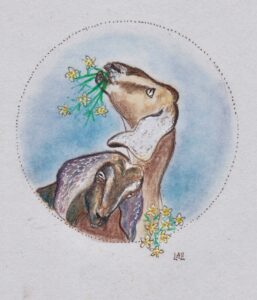When the solstice comes around, I swear I can feel the earth’s axis tilt, towards the sun in December, and towards the darkness, alas, in June. The courting songs of warblers and thrushes give way to the screeching of their insatiable nestlings as I watch the leaves change from light to deeper green, and the hues of the wildflowers intensify as asters, echinacea, and black-eyed Susans replace buttercups and dandelions. And I feel like it’s all downhill now, and dreary November is around the corner.
Yet I love the seasons. During my six decades in the U.S. I slowly made my way north in search of real winters, from the semi-tropical Deep South to North Carolina, Maryland, and at long last Vermont. But while I get excited at the turning of the maples, followed by stick season, snow season, mud season, and, not a moment too soon, dandelion time, the summer solstice sends me into a decline.
Long ago, in my back-to-the-land days, my goats and I used to celebrate the solstice together. We honored the flowering of St. John’s Wort, which coincides with the solstice and with the feast of Saint John the Baptist. A humble perennial weed with small yellow flowers and leaves speckled with transparent dots that look like holes (hence its scientific name, Hypericum perforatum) the Wort has a long and illustrious history in herbalism as a remedy for various ills, most notably depression.
When the yellow flowers opened in midsummer, I would lead Emma and Lizzie (both named in honor of Jane Austen’s heroines) into the field. Unlike sheep, who are grazers, goats like to browse. They wander through woods and fields like foodies at a tapas bar, searching for the trees, bushes, or grasses that are at their tasty nutritional peak.
In the long dusk of Saint John’s Eve when, according to tradition, medicinal herbs are at their most potent, Emma and Lizzie would follow me sedately down the driveway, but would break into a gallop when the patch of Wort came into view. They would plunge into the foliage and chomp with single-minded dedication until, when the sun had almost set, I enticed them with a handful of grain back to the shed to be milked.
After a couple of days, however, they would mysteriously turn away from the decimated stand of Wort and go in search of something that now seemed tastier—a plot of poison ivy, or a honeysuckle hedge. It turns out that, eaten to excess, St. John’s Wort can make livestock susceptible to sunburn, so it’s possible that Emma and Lizzie, born herbalists, knew when enough was enough. Or maybe the plant’s nutritional value began to fade and lose its appeal as the days grew imperceptibly shorter. Whatever the reason, they abandoned the Wort with no apparent regrets and went in search of, um, greener pastures, ones that offered the best possible nutrition for the next stage in a goat’s year—the start of the breeding cycle around the time of the first frost.
One of the things that I miss most about the goats was their connection to the year’s rhythms—the insistent “heats” of autumn, the placid winter pregnancies, the births in the early spring. Even their milk had seasons: the early milk made lovely mozzarella, while the later flow was best for aged farmstead cheese. The goats synchronized me with the seasons, and the dimming of the light was not a cause for sadness but a reminder that midsummer was not too early to start interviewing candidate bucks to father next year’s kids, and to shop around for the best second-cutting hay to sustain the girls through their winter gestation.
Those days are gone now, and with heat and air-conditioning, and no vegetables to grow or critters to care for I am as free to ignore the changing seasons as the dwellers of Dubai’s Burj Khalifa tower are free to ignore the shamals that blow across the Arabian desert. But when I come across a stand of St. John’s Wort I remember Emma and Lizzie galloping down the hill, their long Nubian ears flapping, rushing to their solstice feast.



5 Responses
What sweet memories of your goats. I imagine the babies were a joy, too.
Baby goats, especially if they have been bottle-fed, are as cuddly and affectionate as puppies.
I love the seasons too (she says, looking at the heading-into-fall light, not being sure, but…) and I miss other people’s goats!
The light HAS already started to change…or is it because of all the goldenrod?
Les 4 saisons sont les meilleures! J’aime lire ce que vous écrivez!